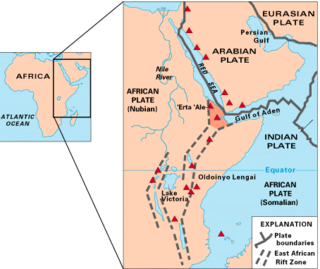The African Plate is a major tectonic plate. It includes much of the continent of Africa, as well as the oceanic crust which lies between the continent and various surrounding ocean ridges. Since the continent of Africa includes the African Plate and the smaller plates to its right, some literature refers to the African Plate as the Nubian Plate to distinguish it from the continent as a whole.[1]

Between 60 million years ago (mya) and 10 mya, the Somali Plate began rifting from the African Plate along the East African Rift.

One hypothesis suggests a mantle plume beneath the Afar region. Another hypothesis suggests the rifting is just a zone of weakness as the plates to its east move northwards.
The African Plate's speed is about 2.15 cm (0.85 in) per year.[2] It has been moving over the past 100 million years or so in a general northeast direction. This is drawing it closer to the Eurasian Plate. There is subduction where oceanic crust meets continental crust (in parts of the central and eastern Mediterranean).
Along its northeast margin, the African Plate is bounded by the Red Sea rift where the Arabian Plate is moving away from the African Plate.
The African, Somali and Arabian Plates were once all part of the great southern supercontinent Gondwana, as was the Indian subcontinent.
References
Wikiwand in your browser!
Seamless Wikipedia browsing. On steroids.
Every time you click a link to Wikipedia, Wiktionary or Wikiquote in your browser's search results, it will show the modern Wikiwand interface.
Wikiwand extension is a five stars, simple, with minimum permission required to keep your browsing private, safe and transparent.
